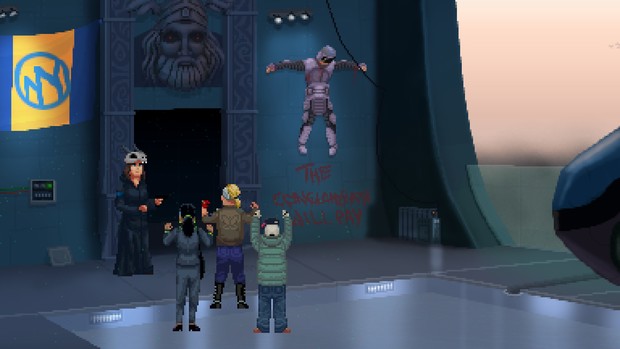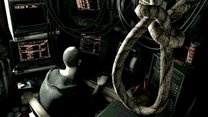Born Punk review

- 0 Comments
Cyberpunk point-and-click isn't able to fully deliver on its abundant promise
A combat hacker with a mechanical hand; a snooty, critical megacorporation CEO; and a hustler android who wants nothing more than to lay down some mad beats with his homies. These are the protagonists of Insert Disk 22’s traditional point-and-click Born Punk, set in the semi-dystopian future of 2155. For all they’re involved with the plot, however, they may as well be sidekicks doing mundane legwork for somebody else’s story, as the trio meander through a vividly realized cyberpunk world towards a climactic confrontation that’s not all it’s expected to be.
Each of the main characters has their own playable prologue. Eevi Rinasdottir, the combat hacker, has such a cool job description that I anticipated being dropped into cyberspace with a variety of virtual tools to get past various metaphorically realized security protocols. Instead, Eevi’s introduction is far more mundane, which is a description that can apply to most of the game experience. Waking from a drunken slumber in her crummy apartment in the city of Bornholm, Eevi’s critical challenge is to prepare a hangover remedy. Then she gets to do a similar puzzle all over again for her equally worse-for-wear drinking buddy, best friend, and adoptive sister Hussar. The two plan on Eevi doing a hack to earn some money, but just as it’s about to start, events switch to the next playable character.
Mariposa Annika del Corral-Flores de Sotomayor is the CEO of Mitsotomo, a mega corporation that runs Bornholm. Her introduction is more promising, as some alien artificial intelligence has downloaded itself into her brain and possessed her body. The rest of her opening sequence is spent clicking on every object in her high-rise, glass-walled office so that the AI can learn about her to impersonate her. Yet despite this inviting premise, surprisingly little is revealed about Mariposa. There are vague hints that although she’s a corporate bigwig, she’s secretly been acting against the company to help the downtrodden of Bornholm. The details are never revealed, though, nor do they ever factor into the plot.
The final protagonist (kinda, sorta) is an android by the name of Grandmaster Flashdrive. He hits the steamy, seedy streets of Bornholm in his frumpy gangsta/rapper clothes. With his power cells wearing down, his goal is to secure a new battery through a series of pretty obscure steps involving a surveillance drone disguised as a moth, a woman selling her organic parts for robotic replacements, killing a pigeon, and a little bit of pixel hunting.

The point of view shifts back and forth between the three leads a couple of times before all the preamble gets out of the way. This prolonged stretch took five hours of Born Punk’s eleven-hour total play time to work through and definitely felt out of balance in the grand scheme of things. Eventually the three characters come together, with each of them becoming inhabited by an AI in much the same way that Mariposa starts off. During this process, Flashdrive’s street-savvy personality gets wiped out, restoring him to his older, more poetical persona of Geronio Marcus-Fallingborg. Coming right at the end of the prologue, it begs the question: why spend so long introducing a character only to effectively kill him off when the game proper begins?
Once the protagonists are united, the AIs ask for their help to reach a secure Eurograv laboratory elsewhere in the city. Here the little group will be able to use the lab’s specialized neural network and human-AI interface technology to extract the artificial personas from their heads. At least, that’s what the AIs tell them. None of the three ever question the AIs’ motives or even how they got implanted. For all Eevi, Mariposa, and Flash care, they seem even less bothered by their circumstances than Eevi was by her hangover.
Fortunately, after the characters are bound in common purpose, the world opens up significantly, with a suite of new locations available to explore as well. The three protagonists work essentially as project managers. It’s their job to go to the various factions in the city and organize them to help with the final assault on the Eurograv lab. The game doesn’t allow for freely switching between them, instead swapping control of the characters based on what locations are being visited. For example, when going to meet an android gang, control switches to the android Flash, with Eevi and Mariposa becoming non-playable and following him around. The non-playable members appear in the inventory bar and can be used like any other item if the situation warrants it.
As the story progressed, I kept expecting something sinister to emerge from the AIs. Perhaps they were evil. Perhaps there was something special about Eevi, Mariposa, and Flash that caused them to be targeted. Perhaps another corporation was pursuing these runaway artificial personalities. Imagine my surprise, then, when Born Punk reached its end just as the trio, having secured the assistance of the necessary allies through the course of the game, invade the Eurograv facility. This was doubly disappointing as (a) the whole sequence is nothing but an extended, non-interactive cutscene with no player engagement whatsoever, and (b) no answers are given about the AIs. The game simply stops with a couple of lines of dialog that suggest the real story about the AIs is ready to begin.

Gameplay is typical of point-and-click adventures. Left-clicking interacts with hotspots and right-clicking examines them. The scroll wheel is also employed, with scrolling up causing the inventory bar to display at the bottom of the screen and scrolling down making the game’s built-in lore database appear. As the characters explore the environment, lore items are added to the latter, detailing this world’s characters, corporations, locations, etc. Most of the background data for Eevi, Mariposa, and Flash themselves is stored in these pages. In fact, I only discovered Flash was a rapper by happening to glance at his lore page, as it’s never mentioned in context. While the lore is a nice addition, I was constantly thinking of the writer’s credo to show, not tell. I would have much preferred to learn about these people and their world through natural developments in the story instead of lengthy hidden text dumps.
While much of the experience takes place in the “real” world, occasionally different characters dip their toes into the virtual reality of cyberspace. I was really looking forward to this, what with Eevi being a combat hacker and the long build-up to her first in-game incursion into this digital arena. When Eevi finally travels there, her normal inventory is replaced with different hacker tools that she can use to bypass assorted security systems. Sadly, these mechanics go underutilized. There’s only one puzzle sequence in the entire game that involves them, and players are even robbed of victory there as the AI in Eevi’s brain steps in at certain points to deal with most of the security threats automatically.
Puzzles are primarily inventory-based, although there are a few instances where it’s necessary to uncover information scattered about in order to unlock dialog options when conversing with various people. Dialog trees are standard fare, presented as text lines to choose from. Occasionally there are some decision-based options that don’t really change anything but are a nice touch anyway. The script itself is frequently long-winded and overwritten. At least it’s not all doom and gloom in a postapocalyptic world, as the occasional humorous line is inserted to lighten the mood.
Born Punk is fully voiced with optional subtitles, and the acting talent does a good job throughout. Eevi has a laid-back delivery broken up with Shatner-esque Captain Kirk pauses. Mariposa is haughty and condescending to the point where I really wished her companions would stand up to her. Flash, in his Flash persona, speaks in higher tones than his more deeply voiced Geronio Marcus-Fallingborg variation. The AI voices have been processed to sound suitably computery.
Playing in the background is an understated score, much of which has that synthetic sound of movies like the classic Blade Runner. Occasionally it drops out altogether to let the ambience of the world breathe with the sounds of constant rain pouring down or traffic driving by. Whenever characters interact with the environment, whether it be opening doors, operating machinery, or Eevi firing her gun, their actions are accompanied by suitable sound effects. It’s worth noting that the game does feature one sound-based puzzle. No visual cues are provided to accompany this, so the hard of hearing will be challenged to move beyond this point. While it should be possible to brute force the puzzle, it would be a tedious chore to do so.
The characters visit a decrepit amusement park, a futuristic zeppelin, a classy restaurant, and even a dank sewer maze, among other locales, and the detailed pixel art graphics are where the game really excels. From the decrepit apartment building Eevi calls home, to the shiny high-rises frequented by society’s upper crust, the futuristic settings are filled with rich visual atmosphere. The darkness of night scenes is penetrated by the glow of neon signs and the lights from office buildings. Rundown, graffiti-tagged suburbia stands in stark contrast to the red, blue, and purple glows of the virtual world. These disparate regions come together in a glorious whole that feel real and lived-in.
Characters are well-animated, and their depictions help convey a sense of who they are. Eevi stands with her legs planted wide apart in a cocky attitude. Flash has a relaxed, stoop-shouldered shuffling gait. Mariposa stands ramrod straight, her purse always ready like a shield. Many of the character models are asymmetrical, such as the slightly tubby Eevi, who has a bionic left eye and hand. Welcome attention has been paid to such details, including individual walking animations to show off the appropriate features. Most areas, too, have at least some background animation, whether pedestrians walking by, various animals scurrying about, or television displays showing news bulletins.
Final Verdict
Born Punk is a game that I really wanted to enjoy more than I did. The thought that kept coming to my mind while playing was, “squandered potential.” The visuals are a treat. The world feels fully realized and is alive with animation. The characters convey a lot of personality through their pixelated sprites and excellent voice work. As evidenced by the lore pages, a lot of thought went into the world-building aspects. It’s unfortunate, then, that it’s all undermined by the tediously extended prologue, the underutilization of cyberspace tools, the highly overwritten dialogs, the characters’ lack of interest in their own AI-infested conditions, and the fact that the most engaging part of the story only starts in the closing seconds of the game. As an opportunity to take in the sights of the rain-drenched streets of Bornholm, this game is a delight. But for those who prefer a little more substance with their style, best to look elsewhere.
Hot take
With dull things to do, a plot even the characters don’t care about, and no real ending just when the story starts, it’s left to the lush pixel artwork, smooth animations, and atmospheric audio to at least partly salvage the dystopic future in Born Punk.
Pros
- Rich cyberpunk atmosphere presented in slick pixel art
- Nice variety of futuristic locations
- Fluid animations
- Well-done voice-overs
Cons
- Prologue is drawn out and the story never engages even its own characters
- Squandered cyberspace concept
- Overwritten dialogs
- Non-interactive endgame
Richard played Born Punk on PC using a review code provided by the game's publisher.










0 Comments
Want to join the discussion? Leave a comment as guest, sign in or register in our forums.
Leave a comment